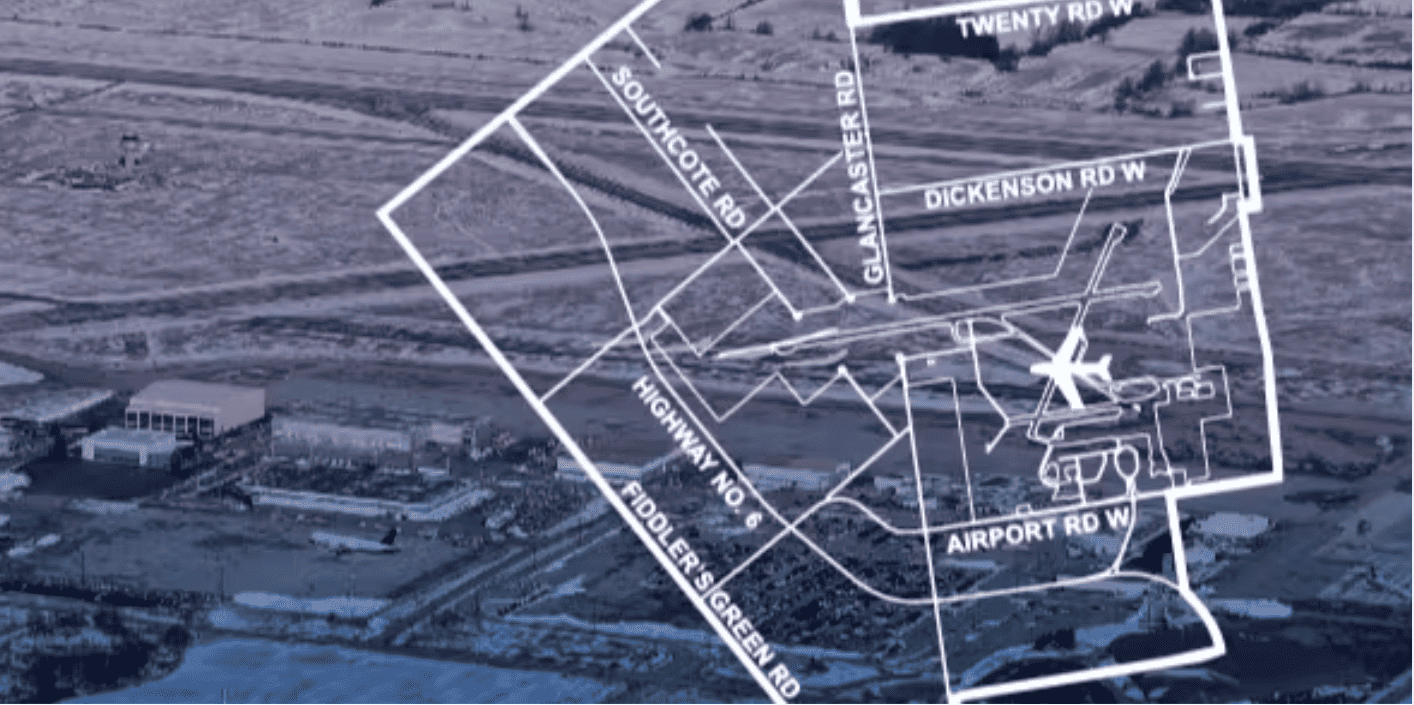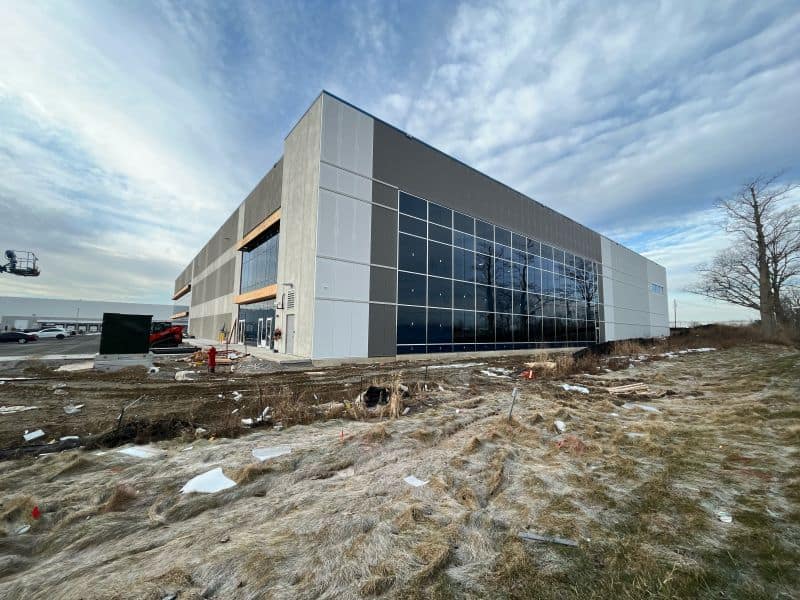$500-million road network for mega Hamilton airport district gets green light amid cost concerns
Published November 17, 2023 at 10:57 am

Hamilton has high expectations for the “aerotropolis” industrial, commercial and residential district near the airport — and it also has great reservations.
Covering 555 total hectares, the so-called aerotropolis, or Airport Employment Growth District (AEGD), is shaping up to be what developers and many in the city hope will become an economic engine near the John C. Munro Hamilton International Airport.
City council backed a new $500-million plan for a road network in the area that’s also described as a business park, rejecting a motion that aimed to defer deciding on it until a financial analysis was completed.
Ward 12 Councillor Craig Cassar had introduced the amending motion, which was defeated 7-9, during the council meeting on Nov. 8.
After defeating the deferral motion, council ultimately approved the updated report, advancing the road network plan to its next phase.
Cassar said his intention with his amending motion was not to obstruct or delay the plan. “The intention is to assure taxpayers, future taxpayers, that we are spending wisely and we’re not incurring them with future debt, which is the situation we are in here in 2023,” he said. “The fact is the report presented to planning committee did not have a financial analysis to support it. … To make a significant decision like this without financial analysis I think is really shortsighted.”
The approved future road network plan could still face changes and appeals based on Indigenous rights and treaties. It will undergo a 30-day review period. Then phases two to five will involve working on the new road locations and other roadways along with ongoing public consultation.
The plan will continue to undergo studies under the Planning Act or Environmental Assessment Act processes and could take 30 years or twice as long to implement.
In his motion to defer the plan, Cassar stressed he was not objecting to the roads that were needed to support the airport growth area and increase the industrial tax base to help reduce the tax burden on residential tax payers. Instead, he was hesitant to approve the plan with a “$500-million maintenance liability.”
“It’s my opinion that we should not approve further investments in roads without understanding that analysis to confirm they’re financially viable,” he told council on Nov. 8. “We’re all very concerned about the 2024 budget, which we’re about to embark on, and the potential tax increase. But I would assert that we would also have to be thinking long-term about the impacts of the decisions we make long after all of us have moved out of these roles.”
Although the new airport district road plan considered the projected traffic demand on roads for the network, it lacked a cost-benefit analysis of the network. The plan was referred to as the Airport Employment Growth District Transportation Master Plan Update, or AEGD TMP.
With the City facing a $2-billion deficit, Cassar said he wanted to “ensure value for money” for Hamilton residents, especially future generations who would be directly affected by the decision.
Ward 1 Councillor Maureen Wilson supported Cassar’s amending motion, pointing out the need to consider long-term operating and maintenance costs. “We know every public asset we build, it’s a liability because it becomes forever our responsibility to operate and maintain,” she said.
In his defeated motion, Cassar flagged the City’s core asset deficit of $2 billion, which includes roads, water, wastewater and stormwater, as an obstacle to the City meeting adequate road standards. The deficit is growing at a rate of $195 million per year, he noted in his motion.

Economic activity was flourishing in 2023 at the airport development area in Hamilton. Property was sold for nearly $21 million, or $326 per square feet, in a newly developed industrial park. COURTESY PANATTONI
Cost to build airport road network to be split between developers and residents
The newly approved transportation plan for the airport district predicted the cost to build the roads would be $500 million. The cost would be split between developers through the form of development charges and existing residents through taxes.
Omar Shams, a project manager who is co-leading the project, said the road network is “supposed to be pay for itself.” The majority of roads will be developed as part of development applications or site plans, meaning most of the cost will be covered by development charges. The City will also help pay for it through a tax levy, Shams said.
Still, Cassar was worried about the future impact. At first, developers, development charges, and a tax levy would pay for it, but it would be “a long-term maintenance liability for the City of Hamilton funded by taxpayers.”
Ward 8 Councillor John-Paul Danko argued that not advancing the proposal would threaten the City’s ability to grow its commercial and industrial tax base. He said it’s the “foundation” for funding policy changes.
“We cannot rely on municipal taxpayers to fund all those initiatives. They are not possible without growing the commercial industrial tax base,” he said, noting that he believes the residential tax burden is the biggest issue affecting Hamiltonians.
Danko said it’s taken a decade for the AEGD or “aerotropolis” to become a significant employment area for the City. “Anything that we do now that could freeze that momentum that is happening is detrimental to the city of Hamilton, is detrimental to the taxpayers of the city of Hamilton,” he told council. “I understand the initiative like I would like to know what the lifecycle cost benefit is, but we have developers right now that are planning hundreds of millions of dollars worth of investment in the City of Hamilton and they need to know that we are committed to building out the road network that they’re going to need in order to service those facilities.”
Norm Schleehahn, director of economic development for Hamilton, said the airport area has recently received lots of applications from developers who are “looking for some certainty in how things are moving forward.”
Among the economic activities in the area, property was sold for nearly $21 million, or $326 per square feet, earlier this year in a newly developed industrial park.
Steve Robichaud, chief planner for the City of Hamilton, said a fiscal impact assessment was done in 2010 when the AEGD was being developed. It found that the area would be net positive $66 million annually from a tax perspective, potentially providing extra industrial taxes and jobs once it is fully developed.
Hamilton Mayor Andrea Horwath said she didn’t support the amendment to defer the plan to do a financial analysis because she feared the impact of the delay and the City’s lack of resources.
“We’ve just got a couple of years to get some really important things done around here and a big part of that is how we resource the work of staff. From what I’ve heard, the resourcing is an issue,” she told council.
She added that delaying the plan could put “a chill” on the industrial and commercial expansion in the employment lands around the airport and send the “wrong signal” to investors.

New road network plan accounts for changes in policies, climate and natural features
City staff presented an update on the transportation blueprint for the “aerotropolis,” or Airport Employment Growth District (AEGD) on Oct. 31, which later received council’s approval on Nov. 8. The updated transportation master plan for the area includes improved connections for all types of transportation. It also makes efforts to avoid disturbing cultural and natural heritage resources and existing residences, and build resiliency to address climate challenges. For instance, new trails and pathways around the edges of natural heritage systems are proposed in the revised plan. In addition, the plan avoids the large forest next to Glancaster Road.
“We have our done best to minimize impacts on anything important there, species at risk or the wetland itself,” said Margaret Fazio, senior project manager for environmental planning and co-lead for the project. “That’s why wildlife crossings will become a feature as part of roads when it’s designed in its final location.”
The last update for the plan was in 2016 after an earlier study in 2011.
Shams, a project manager who is co-leading the project, told council on Oct. 31 that the plan provides a “promising multimodal network” and improved connectivity, such as wider roads and the most direct routes to reduce travel time and emissions. As well, it links communities to nature. Transit accessibility will be addressed later on based on future analysis.
Fazio explained why the plan had to be revised. She noted changes in elements such as cross-sections and the need to add beneficial new right-of-ways. She said there was increased interest in developing the “provincially significant trade area” at the airport, and a need to adhere to road classifications.
“(The airport area is) a supremely important area for economic development in the city of Hamilton,” she said.
Fazio added that the new report “it will be a more implementable plan than the previous plan.”
“It may feel like cart before the horse but everyone is looking for that major guidance,” Fazio said. “Once we get into the details, we will figure out the best way of making it fit. … So while we have the spine now it is malleable, it is flexible to accommodate for important features like natural heritage.”
inthehammer's Editorial Standards and Policies advertising




